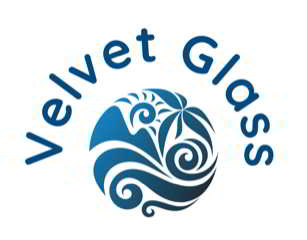Fused glass takes raw sheets of glass that the designer cuts into whatever shapes they want. They then put that glass into a kiln, which is basically an oven with very thick insulation that can go up to over 2000 degrees F. The two (or more) pieces of glass will be heated so that they form a permanent bond. That’s the first round. Then the artist may add more glass to the piece, round the edges, or even connect it with another piece. The final step is to slump the glass into a mold to get the shape we want.
To blow glass, the artist takes what is pretty much a blob of molten glass and blows into it through a tube, like blowing up a balloon. Blown glass can create thinner glass walls of a piece that we can do with fused glass. It is also very fragile. Our fused glass is sturdier and won’t shatter as easily.
Art glass is a special kind of glass which has a specific “coefficient of expansion.” That means that it will expand or contract in a very predictable way. Art glass comes in sheets of many sizes, but also as what we call “stringers” (1mm or 2mm thin rods), and as crushed glass in sizes such as coarse, medium, fine, and powder. In addition, there are glass sheets with added iridescent coatings and even dichroic glass, which was originally invented by NASA. All the glass can be opaque (cannot see though it) or transparent (with color, but you can see through it).
I use glass of all available shapes, sizes, and colors. After years of experimenting, I have settled on only one manufacturer. They are located in Portland, Oregon, and are called Bullseye Glass. Unlike glass manufactured elsewhere, Bullseye glass is highly predictable. They have a long and arduous quality control process. If they say it’s a sheet of transparent cobalt blue glass, it always is.
I’m glad you asked! Because of the unique behavior of glass when it’s heated, I have over 30 programs in one kiln …… and there are three kilns! The first phase is the warm-up. That’s usually a nice, slow progression. At the top of this, the glass arrived at “process temperature.” For example, for fully fused glass, the top temperature is normally 1475F. Now the two pieces of glass have become one. The last step is a slooooooow cool-down. That’s what really takes up most of the time. If you cool it too quickly, it will CRACK. And we don’t want that.
Through the process of fusing, art glass will expand or contract to 6mm. That’s why we start with two pieces of 3mm sheet glass. In that way, the completed piece will be exactly the same size as it went into the kiln.
Oh, we are all tool crazy. The most basic is a hand-held glass scorer. You don’t actually cut glass, you score it to create a weakness. You then use pliers to break the glass along that score. But that’s just the beginning. I have straight glass saws and free-form saws, and even circle scorers. Then there are grinders and sanders, and ……… I’m going to need a bigger studio.
The most basic, and most frequently used, is the slump. With a special program, we heat the glass just enough so that it sags into a ceramic mold and takes on the shape of that mold. We can also put the piece on top of a mold and drape it. One fun technique is to let the glass drop through a mold with a hole in it and make a drop-out bowl or vase. After it has cooled down, we can leave the rim on or cut it off. Another great technique is to mix glass powder with water and put the slurry into silicone molds, like candy molds. I have boxes and boxes of these. Then you freeze the “glass cubes” like ice cubes for about 4 hours. When we unmold them, we put them into a kiln frozen and fuse them into that shape. Want a mermaid theme for a glass plate? There a mold for that!
Ah, the sky’s the limit. You can make wall hangings, free standing pieces, mobiles, wind chimes, mandalas or even an entire end table! These do take some time, though. They go through several fusings and a lot of work in between. It won’t done in one workshop. I have done several custom projects that have gone on to their forever homes. Most of these take me 2 – 4 weeks from design to completion.
Absolutely. After it has been fused at nearly 1500 degrees, a little hot water won’t faze it. I have put several plates in the dishwasher. No problem.
Of course! More than once. I think I stood in the doorway of one studio for over 3 hours, just fascinated. But here at home there’s the Corning Museum of Glass in New York state. Awe-inspiring.
